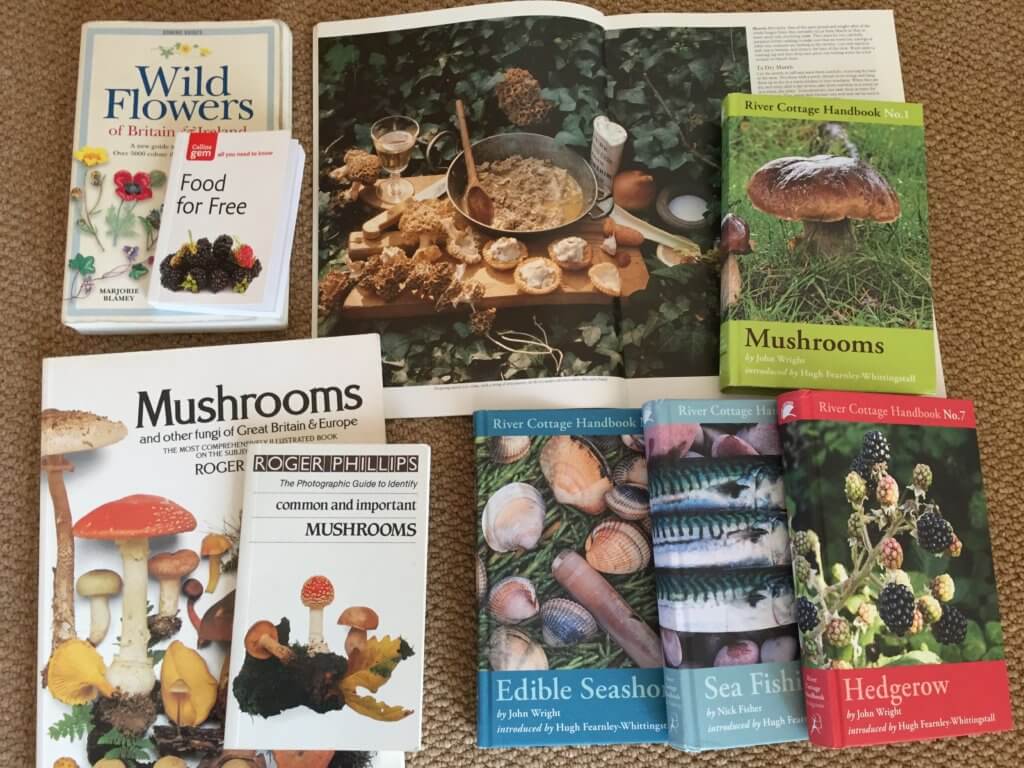
That’s useful books used by me (not written by me) just in case that wasn’t obvious.
These are a few of the books I refer to most often or have found especially inspiring. Mainly they are about the essential business of identification but they also describe how to go about tracking down edible species and what you can do with them once you have found them.
There are four books in the excellent River Cottage Handbook series that I can’t recommend highly enough. They are Mushrooms, Hedgerow, Edible Seashore, and Sea Fishing, the first three all by the same prolific author, John Wright. Together they cover the great majority of useful wild foods. They are full of detailed information (and excellent photographs), but are also thoroughly entertaining. I value the way they lend a sense of normalcy to the whole process because the authors come across as intelligent and down to earth, but also have a sense of humour. In the modern world leaping into a ditch to peer at fungi emerging from the leaf litter can be seen as rather odd. Reading these books helps you to realise that, on the contrary, it all makes very good sense.
Roger Phillips has produced many excellent large-format photographic guides over the years, mostly involving wild and domestic plants. There are two I use frequently – Wild Food and Mushrooms, first published back in the early 1980s. Wild food has lavish, full-page images of meals prepared from wild ingredients that are guaranteed to make you feel hungry and help get you out of the house. I also use his slimline photographic guide to Common and Important Mushrooms which is handy for taking into the field. In this context ‘important’ tends to mean the ones that are nice to eat and the ones that might kill you.
Richard Mabey’s classic Food for Free was (amazingly) first published almost 50 years ago and was in large part responsible for the surge of interest in wild plants and fungi as a food source. By the 2003 edition he felt able to say in the preface that ‘the subject has lost the slight note of eccentricity it once had……’ and that foraging has ‘become an acceptable family pastime again’. The tiny Collins-gem edition I have weighs less than the iphone I use to take the blog photos and packs in an incredible amount of information including artwork and photographs. The illustrations are so small that they are not always definitive but it’s still a great book to have in the field. It can help you decide if something is worth taking a chance on so that its identification can be confirmed once you are back at home. To that end it’s useful to have a comprehensive field guide for plants and there are many high-quality options out there. The one I tend to use most is Wild Flowers of Britain & Ireland by Blamey, Fitter & Fitter.
These days a huge amount of information is available online. It pains me to admit it but often I can get the information I need more quickly by typing a few words into a search box than by trying to work out if I’ve got the relevant book, and if so, what I’ve done with it. I find it particularly useful to be able to search for images of a particular species just to help confirm an identification. For the more common species there are huge numbers of images available, in contrast to the necessarily limited selection presented in field guides. Species can sometimes be mislabelled online but if you do enough searches you will come to trust certain sites as reliable sources of information.
In true Desert Island Discs tradition, if I was recommending just one source of information for anyone starting out it would be Mabey’s Food for Free. It has an inspiring introduction to the subject that sets modern foraging in context with the long history of human exploitation of plants in Britain. It is available in various editions and formats but the mini-version takes up almost no space at all in your coat pocket and you can find it online for less than the price of a pint. By the end of your first walk you may well have found enough to have made your money back.
[registration_form]